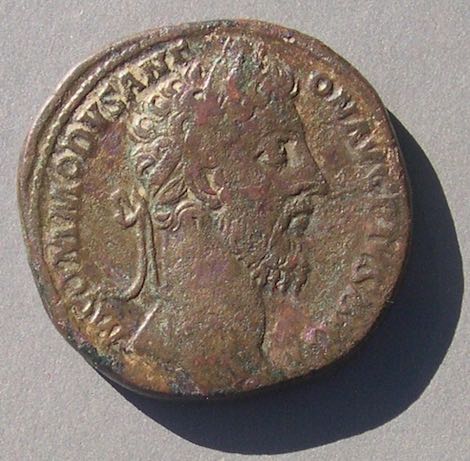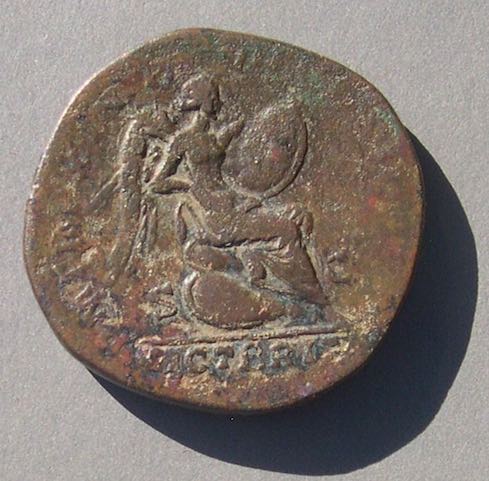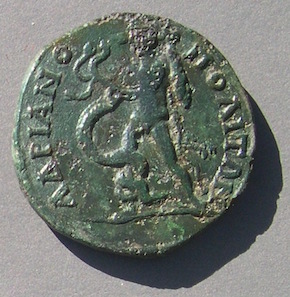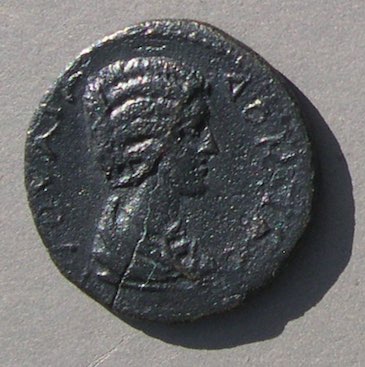Here are some possibilities. [For the key to abbreviations, see below.] Click on the image to go to a page listing reference works (if that page has been completed). See the end of this page for more links.
The portrait-series of the Roman emperors:
A profile portrait of emperor
Philip I "The Arab", 244-249 AD.
An "antoninianus" or simply, a "radiate". 22 mm. Common.
IMP PHILIPPVS AVG
ADVENTVS AVGG, Philip riding horse left, rasing righthand and holding scepter in left
arriving (ADVENTVS) at Rome.
# There are about 70 senior emperors who were recognized at Rome and 200
Romans with portraits on imperial coins including wifes, sons, and usurpers.
Beautiful Greek coins from city-states:
Corinth, silver stater, 21 mm.
A lovely rendition of Pegasus flying left
and Athena facing left in a Corinthian helmet (tipped back)
with a cornucopia with two wheat ears behind.
# Thousands
Roman Republican denarii:
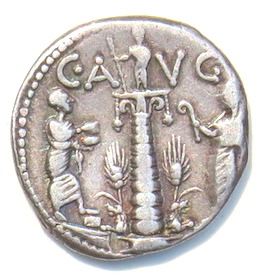
A Roman Repubican denarius of the moneyer C. Minucius Augurinus
c. 135 BC, 18 mm
with helmeted head of Roma right, ROMA behind, X below chin.
A representation of the bronze column erected outside the Porta Trigemina to
L.Minucius Augurinus in commemoration of his successful attempt in B.C. 439,
when prefect of the corn market, to reduce the price of corn, as the people were
suffering from a grievous famine. This coin honors the family of the moneyer
by commemorating an event in the distant past.
# c. 500 Republican denarius types
Roman Coins and Their Values, Volume I, by David Sear
Greek Sicily


Syracuse, Agathokles, ruler 317-289 BC
(His name in Greek on the reverse)
Silver, 26 mm. 17.02 grams.
This piece may have been struck in North Africa at the time of his attack on Carthage.
# c. 45 cities, each with many types, some of which are fabulous and the most artisitic coins of all time
Book Ref: Hoover, Handbook of Coins of Sicily
The family of Constantine:
Constantine (Augustus, 307-337) struck as Caesar 306-307
at Trier (PTR mintmark) with the common
GENIO POPVLI ROMANI reverse, with Genius standing left holding
patera and cornucopia.
29-28 mm.
Constantine minted for his mother, wife, and four sons, as well as
more-distant relatives. One or another ruled until 363 AD.
# nine relatives on coins, hundreds of types, most of which are very inexpensive
Parthian:
Parthian King Mithradates II
on a silver drachm, xx mm
The Parthians ruled the region of modern Iran and Iraq
from the third C. BC to the third C. AD.
# 46 rulers, each with drachms and tetradrachms
Web Ref: parthia.com
Book Ref: The Coinage of Parthia, by David Sellwood
Book Ref: Parthian Coins and History, by Fred Shore
Sasanian:
Sasanian King , 5xx - 6xx AD
Silver drachm, xx mm and xx grams.
The most common Sasanian coin ruler.
The reverse type of two attendants on either side of the fire altar
of their religion is used by every king for centuries.
# xx kings
Book Ref: Sasanian Coins by Sellwood, Whitting & Williams
Cities of the Greek world
Byzantine (copper or gold or silver, or all three):
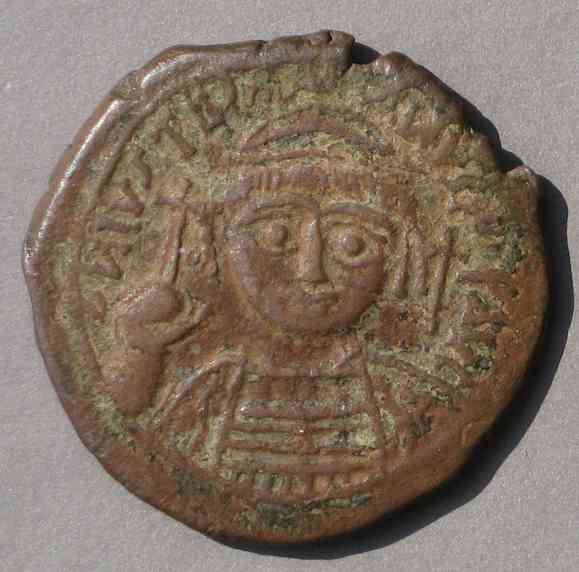
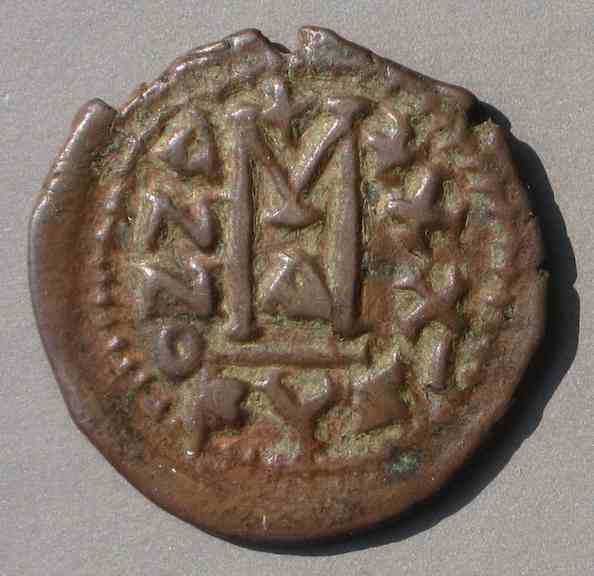
Byzantine emperor, Justinian, 527-565 AD
Year 31 of his reign: XXXI down the right
Mint of Cyzicus: KYZ in exergue
M = 40 in Greek, for the denomination, 40-nummia
Web Ref: http://www.wegm.com/coins/byindex.htm
Book Ref: Byzantine Coins and their Values, by David Sear
Byzantine Coins (the book, not the pamphlet) by Philip Grierson
# 2600, not including date varieties
The "Twelve Caesars":
Nero (54-68 AD), the sixth of the 12 Caesars set,
which begins with Julius Caesar and ends with Domitian.
A silver denarius, 19-18 mm.
NERO CAESAR AVGVSTVS/SALVS
# Twelve emperors
Book ref: Roman Coins and Their Values, Volume I, by David Sear
A particular Roman emperor, any emperor, e.g. Probus, Augustus, Trajan, Gordian III, or Maximinus Thrax (The Giant)

Roman emperor Probus, 276-282 AD.
IMP C M AVR PROBVS AVG
/SOLI INVICTO, facing quadriga with Sol, the sun god, driving
Bust left, holding spear in right and shield in left, with crested helmet.
Probus is famous for issuing many attractive varieties of obverse bust.
# depends upon the emperor, of course. For this emperor, Probus
there are hundreds (really thousands) of obviously different varieties
Web Ref: Numerous sites for various emperors. For Probus: http://probvs.net/probvs/
Book Ref for Probus: RIC V.II
# several to dozens to hundreds to thousands, depending upon the emperor
Coins with some connection to the Bible:
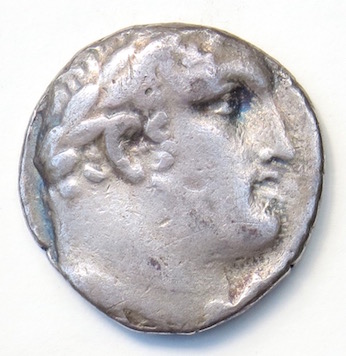
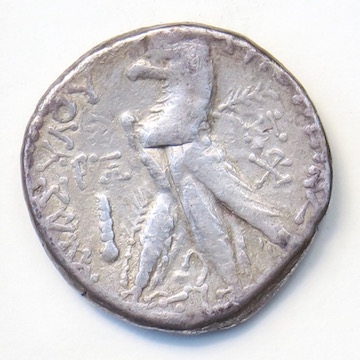
A "shekel of Tyre" which has been thought to be the type of the
"30 pieces of silver" paid to Judas for betraying Jesus to the Romans.
25 mm.
Laureate head of Melquart right
Eagle left
Various symbols in the field, including the date PΞ = 160 of the era of Tyre
= 34/5 AD.
# hundreds
Book Ref: Guide to Biblical Coins, by David Hendin (5th edition)
Early Christian symbolism on Roman coins:
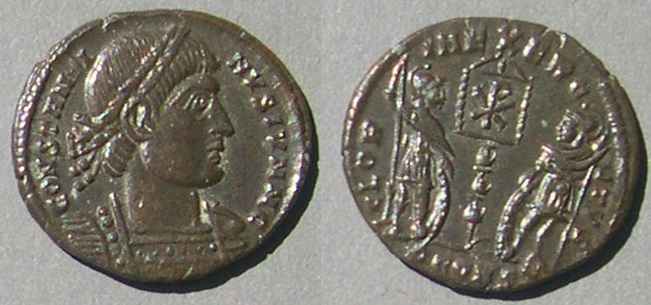
Emperor Constantine II, son of Constantine
the first emperor to promote Christianity
Note the chi-rho symbol, a monogram of the first two letters (X P) of "Christ" in Greek
on the standard on the reverse.
Web Ref: http://esty.ancients.info/Christian/ChristianSymbols.html
The Seleucid Kings:

The Seleucids ruled part of Alexander the Great's empire after his death.
King Antiochus III, 223-187 BC.
Tetradrachm. 27 mm.
His head right
Apollo seated left on omphalos, holding arrow and resting left on bow.
Book Ref: Handbook of Syrian Coins: Royal and Civic Issues, by Oliver Hoover.
# 35 rulers and wives, more than 1000 types
Alexander the Great:
Alexander the Great, 336-323 BC, lifetime issue
Silver tetradrachm. Babylon mint.
26 mm. Thick.
Head of Hercules in lion-ski headdress right
Zeus seated left holding eagle and long scepter.
Down the right side: AΛEΞANΔPOY ("of Alexander")
The monograms in the reverse field and below the seat
help identify the mint.
# This basic type, with more than 1000 variants, was issued from
many mints over the course of two centuries.
Crusader:
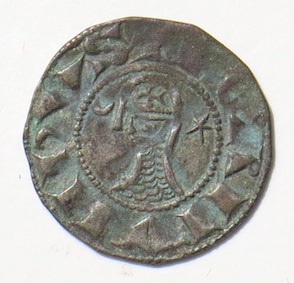

Crusader in helmet left, with cross and chain mail shirt
King Bohemund IV, 1203-1216 and 1218-1223
Struck at Antioch
A thin silver penny, 18 mm.
His name in medieval font around
Cross in circle, city name in medieval font around
Book Ref: Coins of the Crusader States, second edition, by Malloy et al., #76a, page 219
# 600
Turkoman Figural Bronze (Arabic, Foes of the Crusaders):

Figure with sword holding severed head
Legend in Arabic
31 mm.
Arab ruler Husam-ad Din Yuluq-Arslan,
struck 596 AH = 1199/1200 AD.
Most Arabic coins have only legends, not pictures, but during the crusades
a few dynasties issued "figural" coins. Many of the types are inspired by
earlier Byzantine types and many have astrological allusions. Some think
this type represents Mars in Aries.
Spenger-Sayles 36
Book Ref: Turkoman Figural Bronze Coins and their Iconography, by
Spengler and Sayles, in two volumes.
# more than 100
Myths (on Roman provincial coins)
Roman provincial cities that minted coins (possibly just in some region, like the decapolis):
Ancient Imitations
Cities visited by St. Paul:
Ships:

Roman emperor Commodus, 180-193 AD, on a base silver tetradrachm
minted at Alexandria, Egypt, with the image of a cargo ship and
the famous lighthouse of Alexandria.
24 mm, thick.
Struck year 29 (KΘ)
Emmett 2542, Sear 2.5927
Ref catalog: CNG 73 (2006, Sept. 13) 1130 ancients, with a collection of 98 ships on coins
# 200?
A Greek stater or tetradrachm from each major city
The tetrarchy (284-305 AD, Diocletian, Maximianus, Constantius I, and Galerius):

A very common "follis" (27 mm) of Diocletian (284-305).
(This one is thinly surface-silvered, as were all originally,
but it is uncommon for any silver to remain)
Diocletian introduced this new, larger, denomination c. 293 AD.
This is, by far, the most common reverse:
GENIO POPVLI ROMANI = the Genius (spirit) of the people of Rome
# Four emperors, dozens of types each
Book Ref: Roman Bronze Coins from Paganism to Christianity, 284-364 AD, by Victor Failmezger.
Athens:

A tetradrachm of Athens, struck c. 449-413 BC. 23 mm and very thick.
With a small "test cut" at 11:00 to cut through the surface to test the silver content.
Athena in a crested helmet right.
Owl standing right, head facing.
# Half a dozen denominations, several style and type changes over the centuries, but
remarkably few widely different types.
Athens, conservatively, used the same type for very long period of time.
Book Ref: Handbook of Coins of Northern and Central Greece, by Oliver Hoover, lists
over 200 types, most very rare and seldom seen. The number of types normally seen is far less,
unless you count varieties of "New Style" tetradrachms which he did not.
The "new style" coins of Athens come in hundreds of varieties.
The Greek gods:
Women, Roman:


Lucilla, wife of emperor Lucius Verus and sister of Commodus, who reigned 180-193 AD.
Silver denarius. 19-18 mm.
IVNONI LVCINAE, "Juno, bringer of light"
Juno seated left holding flower and a child
# dozens of Roman women with hundreds of types
Sale Catalog Ref: Malter auction XXVIII, Dec. 8, 1984 had 172 coins with Roman women.
Women, Royal Greek:

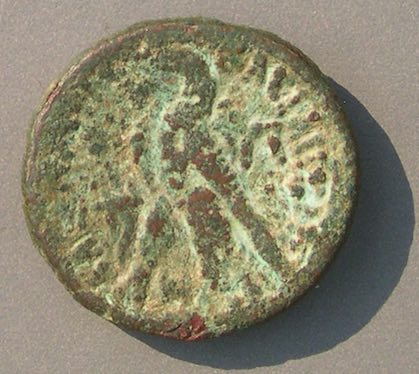
The famous Cleopatra (Cleopatra VII, of Ptolemaic Egypt), d. 30 BC
26 mm. An "80 drachm" copper piece.
Her portrait right. Eagle standing left.
Book Ref: Portraits of Royal Ladies on Greek Coins, by. L. Forrer.
# 225 types in the cited book
Animals (on Greek coins or on Roman coins):

The Romans and Greeks depicted many exotic animals on coins
This one is a camel on a coin of Roman emperor Trajan, 98-117 AD
who annexed "Arabia" (now southern Jordan) and used the camel as a
symbol of it.
# thousands of types, c. 50 different animals, more if sea creatures are included.
Horses:


Maroneia, a city in Thrace, c. 495-449 BC.
This is a Greek silver drachm, 17 mm, from
with a horse protome (front half) and a ram's head
# Horses are extremely common on ancient coins, both Greek and Roman.
Many are galloping free, and even more are riden or pulling chariots.
Dogs, Canines:

Roman Rebublican denarius. 19-18 mm.
Moneyer C. Postumius. 74 BC.
Bust of Diana right, with bow and quiver
hound running right, spear below.
The hound accompanies Diana on her hunts.
C.POSTVMI in exergue
# dozens
Lions:


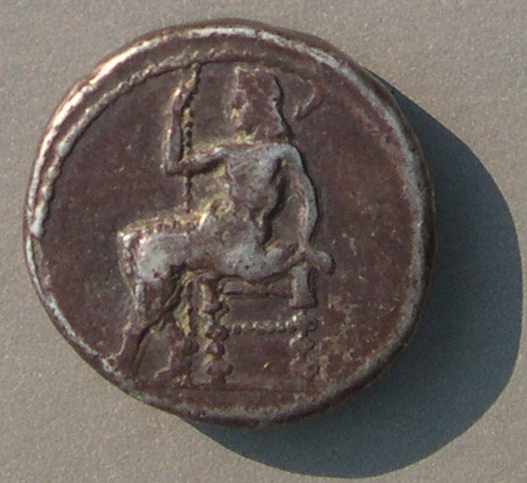
Stater (or Shekel) of Alexander the Great
a lifetime issue struck at Babylon just before he died in 323 BC.
22 mm and very thick
lion walking left
Baal seated left, holding scepter
# Hundreds. Lions are common on both Greek and Roman coins.
Birds:

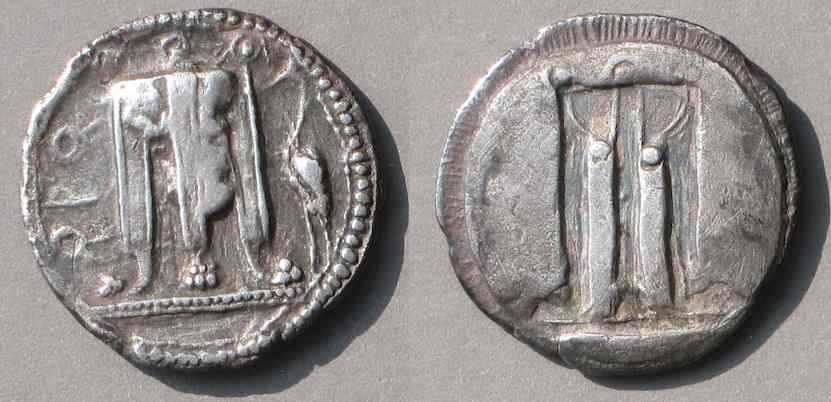
Stater of Kroton, in southern Italy, c. 480-420 BC
23 mm.
a tripod caludron, stork to right
incuse tripod cauldron
# a dozen species, hundreds of types.
Eagles are extremely common on ancient Greek and Roman coins
and could make a theme all by themselves.
Elephants:


A drachm of Roman Alexandria, Egypt
struck under emperor Trajan (98-117)
Emperor in a quadriga of elephants
# scores
The "zoo" series of Gallienus (Roman emperor 253-268):
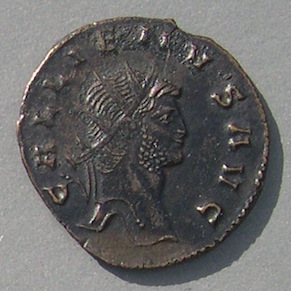

Roman emperor Gallienus, 253-268
21 mm. An "antoninianus" or, more simply, a "radiate" (from the radiate crown on his head)
Stag standng left
DIANAE CONS AVG around
This series includes both real and mythological animals.
# 28 if you count left facing and right facing as different, 54 if you include varieties of stance.
Book Ref: The Cunetio Treasure, by Besly and Bland
Web Ref: http://www.forumancientcoins.com/gallery/thumbnails.php?album=4614
Facing heads on Greek coins:
City of Larissa, Greece. 19-18 mm.
Facing head of Larissa, slightly left
Horse about to roll
# 363 in the cited book, and many others in small fractional types.
Book Ref: Facing Heads of Ancient Greek Coins, by Agnes Baldwin
Architectural (Roman imperial or Roman provincial):
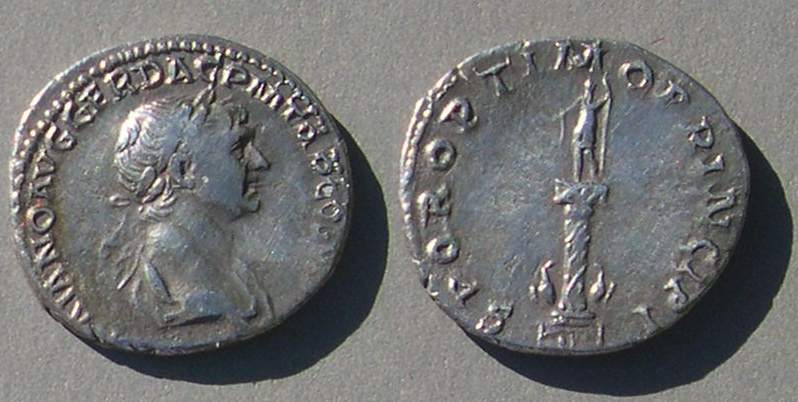
The column of Roman emperor Trajan, 98-117
depiciting his Dacian wars on a huge spiral frieze,
on a denarius, 20-18 mm.
The column is still standing in Rome.
Book Ref: The Monuments of Ancient Rome as Coin Types, by Philip Hill
Book Ref: Coins and Their Cities: Architecture on the Ancient Coins of Greece, Rome, and Palestine,
by Martin Price and Bluma Trell.
Web Ref: http://www.romancoins.info/VIC-Buildings.html
# 203 in Hill, which is devoted to the city of Rome alone. 517 in Price and Trell, which is only a selection.
Roman Alexandria, Egypt
Syracuse, in Sicily
Greek Kings

Ptolemy I, King of Egypt 305-283 BC
Struck at Alexandria.
Tetradrachm. 27 mm. 14.21 grams.
His bust right/Ptolemaic eagle standing left on a thunderbolt.
"of King Ptolemy" in Greek.
Book Reference: Royal Greek Portrait Coins, by Edward Newell
is an excellent, inexpensive, and thin reference work with substantial stories of the rulers and one coin of each ruler pictured.
# c. 200 kings for all dynasties and regions, but specializing by dynasty or region is common
(see "Seleucid Kings" and "Alexander the Great" above)
References to Specific Roman military victories
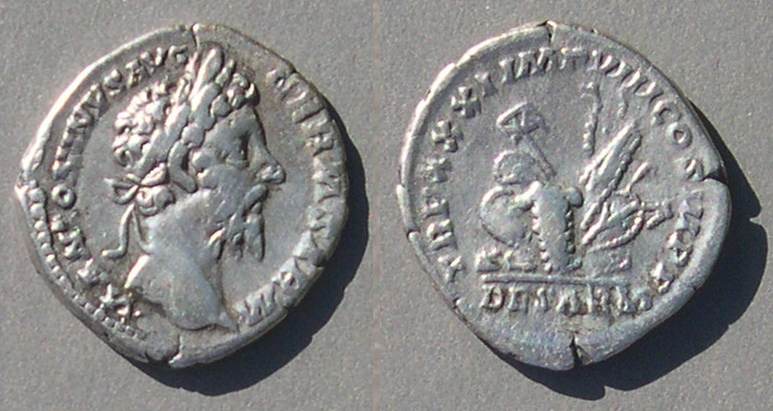
Marcus Aurelius, 161-180 AD
defeats the Sarmatians
DE SARM in exergue,
TRP XXXI IMP VIII COS II PP around a pile of arms
M ANTONINVS AVG GERM SARM around his portrait
Silver denarius, xx mm.
# hundreds, but specializing by emperor is common.
Augustus, Trajan, Marcus Aurelius, Septimus Severus, Gallienus and others have
numerous types from the theme.
Carthage:
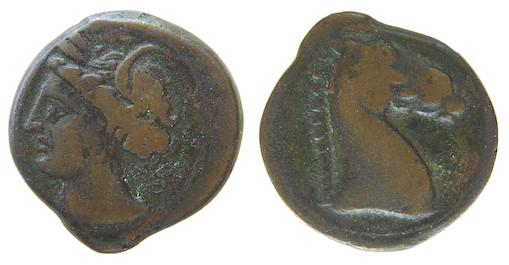
Bronze of Carthage, c. xxxx
head of Tanit left/horse head right
# a hundred types, most somewhat similar to each other,
not counting the coins of Roman and Byzantine Carthage
(It became a mint again in late Roman times c. 296 under Diocletian.)
"Campgates". Mostly late Roman copper coins with city gates:
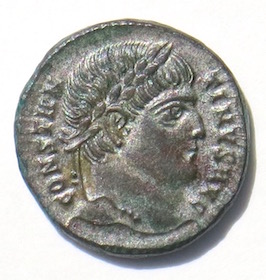
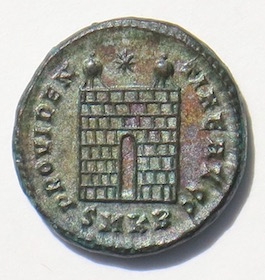
Constantine (307-337)
A lightly surface-silvered AE of 18 mm
Camp gate (city gate), struck at Cyzicus
(mintmark SM K B where K is for Kyzicos, B is for the second workshop,
and SM abbreviates Sacra Moneta, Sacred Mint)
These are extremely common.
# a few types for several emperors, but also a dozen mints, and hundreds of varieties in this time period
and other, similar, reverses in other time periods. This example depicts 8 tiers of stones;
some collectors even care about the number of tiers which can vary from 6 to 16.
Web Ref: http://www.beastcoins.com/Topical/Architecture/Campgate.htm
A type set for emperors Valentinian (364-375) and later:

Valens, 365-378
An "AE3" xx mm.
GLORIA ROMANORVM
emperor dragging capitive right, holding standard in left
ANTS = Antioch mint, 6th workshop
Valens is most famous for losing the disastrous "Battle of Adrianople".
# From Valentinian through Theodosius II (364-450 AD) there were
10 emperors and a few wives and usurpers, 83 copper types, each issued by 1-5 emperors.
Web Ref: http://esty.ancients.info/ricix
Book Ref: RIC IX covers most of this period and RIC X covers the rest.
River gods:

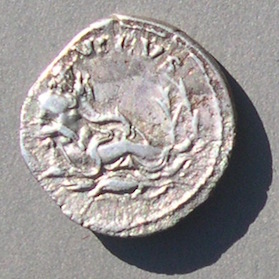
Roman emperor Hadrian (117-138 AD)
Denarius.
Hadrian traveled widely and commemorated his visits to various regions of the empire
with coins illustrrating and naming the region. In this case, the river god NILVS is named.
He reclines with a crocodile left below, reeds in front, holding a cornucopia.
# dozens of imperial types with river gods and hundreds of provincial types
Sale Catalog Reference: Helios 3 (2009, April 29-30) an amazing collection of
482 imperial and provincial coins with river gods
Victory (images of the personification):
Victory walking left, holding wreath and palm branch over left shoulder
on a denarius, 19 mm, of Caracalla (198-217 AD) with reverse
VICTORIAE BRIT marking a victory in Britain.
# most Roman emperors, often numerous types each, and very many on provincial coins,
as well as many on Greek coins.
Late Roman silver coins:
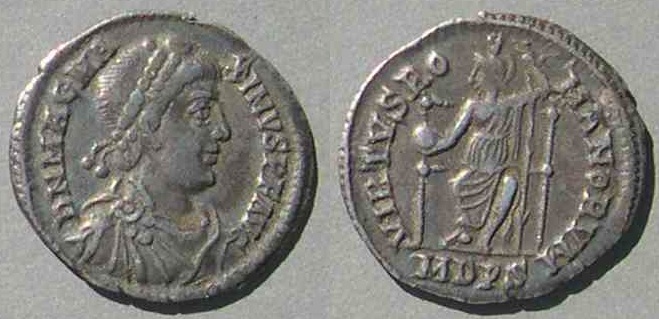
A siliqua of Magnus Maximus (383-388)
17 mm.
Struck at Milan
VIRTVS RO-MANORVM
# hundreds.
Book reference: Roman Silver Coins, volume V, by Cathy King
is devoted to late Roman silver.
A mint city throughout time, e.g. Cyzicus, which began minting Greek coins before 500 BC and continued through Roman times and Byzantine times to the 600s AD.
A portrait series of Greek kings
"Celtic" imitations (from the Balkans and the Danube region)
Kings of the Bosporus
A particular Greek city (e.g Taras = Tarentum)
Personifications (on Roman coin reverses)
Commemorative
Greek fractions:
Gaul
Britain
Dark Ages (Ostrogths, Vandals, etc.)
Countermarks
